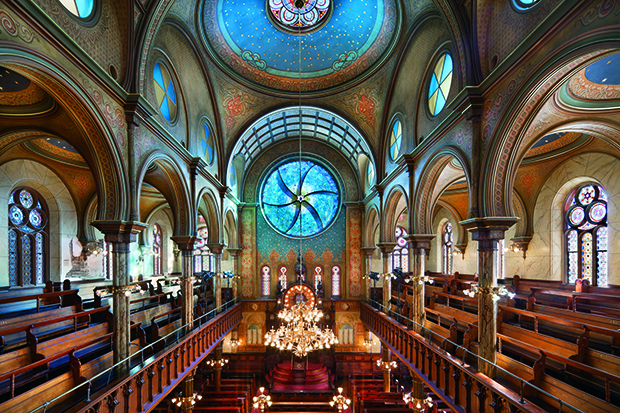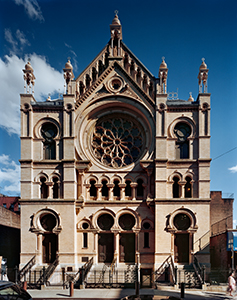NYC: As Many Jewish Sites as in Israel

By Sandy Nesoff
The old saying indicates that “travel broadens one’s perspective,” but it often overlooks your own backyard.
London is fabulous; Paris is romantic; Venice is exquisite, Rome is historic. Then there’s New York.
Seasoned travelers will tell you that you often miss what’s in your own backyard. That’s never been truer than in the case of New York City.
For anyone who has traveled to any extent, and especially to the cities named above, the knowledge that New York is perhaps the most exciting city in the world is no secret. There is something for everyone from the bumper crop of ethnic restaurants to cultural festivals and heritage sites.
The Jewish presence in the New York area burgeoned in the 17th century when Jews from Recife, Brazil emigrated north in search of religious freedom. The population, although on the decline today as more affluent Jews migrate to the suburbs, is still the greatest outside of Israel. There are some two million Jews here with 972,000 of Ashkenazi descent.
New York is the focal point and headquarters for Hasidic communities of Satmar and Lubavaitch sects. Most in these communities keep to themselves, centered in various areas in Manhattan and Brooklyn, and live much as they did in European shtetls.
Interestingly there are an estimated 170 languages spoken throughout “The City” making it a veritable United Nations.
Again, interestingly, one of the fastest growing populations is Islam with an estimated 600,000. Prior to 1970 there were only about a dozen mosques in New York City. Today there are more than 100.
Sites of interest to Jews in New York City abound. There are museums, entertainment centers, restaurants, and monuments. Jews, as with other visitors to New York, may focus on sites of particular interest such as ethnic and heritage, but they do branch out to sample the vibrant feel of the city’s pulse.

With the rich cross-section of ethnicity many people come for an ethnic booster shot or to bring their children for a first hand view of how their ancestors lived. The Lower East Side may not be as solidly Eastern European Jewery as it was in the last century, but there is still a strong presence with historic synagogues, eateries and merchants carrying on the old traditions.
It’s easy enough to set up an itinerary for an ethnic visit to New York by simply going on-line and punching in to the task bar of Google “Jewish ethnic/heritage sites in New York City.” The results will cover more than you can in one or two visits.
For the most part Jews settled in Lower Manhattan, congregating in the Lower East Side, brimming with tenements and walk-up apartments. Most couldn’t even afford a telephone and it wasn’t uncommon to hear someone step out of a candy store (are there any real ones still around?), yelling “Mrs. Katz, there’s a telephone call for you.”
Mrs. Katz, or more likely one of her young children, would race down the stairs to take the call from the pay telephone in the store.
The American Jewish Historical Society, at 15 West 16th Street, is an example of what’s available. Founded in 1892 it is arguably the oldest national ethnic historical organization in the United States. It collection boasts more than 20 million documents, some 50,000 books, photos and artifacts that reflect the Jewish presence in the United States since 1654.
One of the items in its collections is a handwritten copy of “The New Colossus” by Emma Lazarus, 1883. This notebook page is the only surviving copy of The New Colossus in Emma Lazarus’s own hand. She wrote the poem for a charitable auction in 1883 to raise funds for the Statue of Liberty pedestal. After her death the poem was inscribed on a plaque inside the base. The poem has become an iconic part of the statue’s legacy as a welcoming beacon for new American immigrants.
For information on the AJHS go to www.AJHS.org/about.
There are many ancient (for the United States) synagogues in New York City. During the last century it wasn’t uncommon for there to be such a place of worship every block or so outside of Midtown Manhattan. Little shuls abounded in the lower level of apartment buildings and catered to a very local congregation.
But there were magnificent edifices as well. The Eldridge Street Synagogue, built in 1887, still stands today as glorious as it was in its heyday. The bold towers displaying the Mogen David proudly announce to the passing world what it is.
The shul is decorated in a very ornate Moorish design as was common in Spain, Morocco and the surrounding area. Its congregants were primarily immigrants who came from that part of the world and had a strong desire to transplant their heritage.
For information on services and tours, www.eldridgestreet.org/newcomers/.
One of the biggest draws for the predominantly Jewish Lower East Side were the streets filled with pushcart vendors. They long ago slid quietly into the pages of a near-forgotten history. Today there are still bargains to be obtained in those same streets, but in small storefront shops that may be quaint but can never recapture the panache of a street lined with pushcarts selling everything from tomatoes to work boots. There was the cacophony of the vendors calling out to promote their wares and the babble of languages and conversation as passersby eyes viewed the merchandise.
Some things can never be recreated. You can show pictures of the tenements, of the pushcarts, of families dressed for shabbos services in the tiny shuls or those in resplendent finery walking to Eldredge Street.
But it is impossible to capture the sound, the smells, the feeling of walking down these crowded streets. These displays are not in museum cases, but rather in the minds and memories of people old enough to remember what it was.
A walking tour of the Lower East Side means a lunch stop at the iconic Katz’s Deli made famous in the movie “When Harry Met Sally.” The deli is also a d’rigeur stop for major politicians on tours of New York with a coterie of press in tow to photograph them chomping down on a hot dog or picking away at a knish.
It’s rare that the deli isn’t crowded with lines six or seven deep crowding the counter waiting for the thick sliced pastrami or corned beef. Getting a seat at a table is an adventure all its own.
There are other kosher or kosher-style delis in New York from the famed Second Avenue Deli (now located at 162 East 33rd Street in Kip’s Bay) with its equally famed hot pastrami. It was forced to move from its decades long location on Second Avenue in a contretemps with the building landlord but appears to have maintained its loyal client base.
Further uptown near Carnegie Hall is the aptly named Carnegie Deli. Across the Street is Sam Ash’s Deli and a block away, the hangout of many theater and sports personalities, the Stage Deli.
All of them serve their famously overstuffed sandwiches. One man, obviously a tourist, asked the grizzled old waiter, after looking at the overstuffed sandwich in the Carnegie, if they had a children’s menu. The disdainful look from the waiter was all that needed to be said.
Anyone who has ever eaten at kosher or kosher-style restaurants knows that waiters received their training in a military boot camp and brook no silly questions and only provide service because they have no choice in the matter. Emily Post would have a heart attack in any of these establishments.
No trip to New York City is complete without downing a pastrami or corned beef sandwich at one of these establishments. The main requirement is that you forget about a calorie count until the following day.
New York City is a continuing festival of street fairs ranging from the Ninth Avenue Food festival featuring a plethora of delicacies from virtually every corner of the world, to the Green Market at Union Square.
Check out www.NewYorkStreetFairs.com for a comprehensive listing of what is going on during any particular day.
If there is any downside to these visits to New York it is the parking problem. Taking mass transit is not always the answer because, although the subways and buses offer comprehensive routes, they are not always convenient to where you may want to go; especially if you are traveling to more than one section.
There is obviously far more to New York City than can be easily covered in any one article. The black and Hispanic sections of Harlem that once were heavily populated with Jews are well on the way back with many interesting sites and eateries; China Town (and what would Jewish cuisine be without a traditional Chinese meal?) and the adjacent Little Italy still hold the charm they had decades ago. But check this sector out quickly because Chinatown is encroaching on Little Italy so rapidly that you may soon see Pizza-lo mein on a menu.



